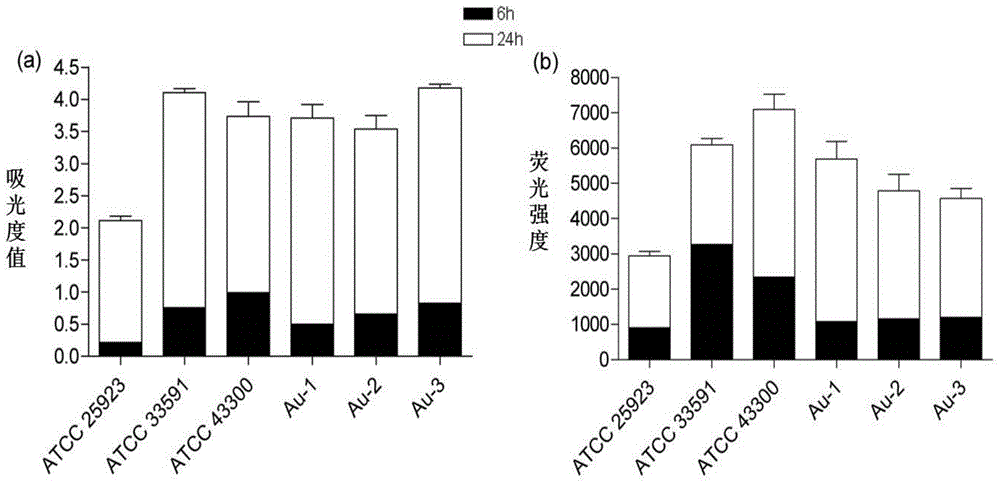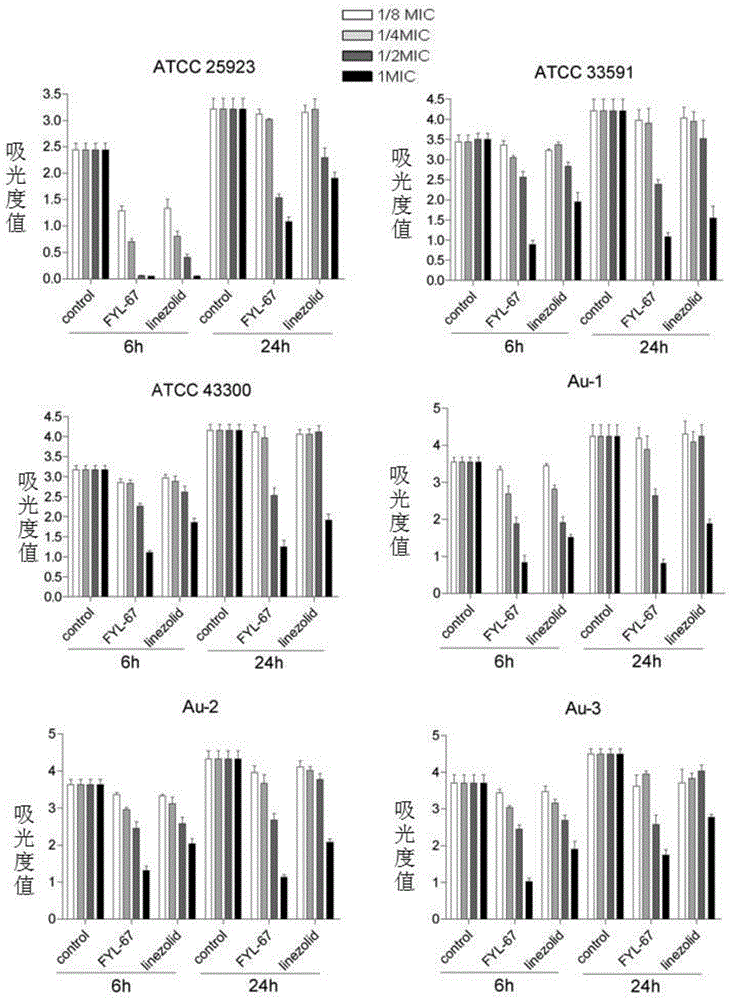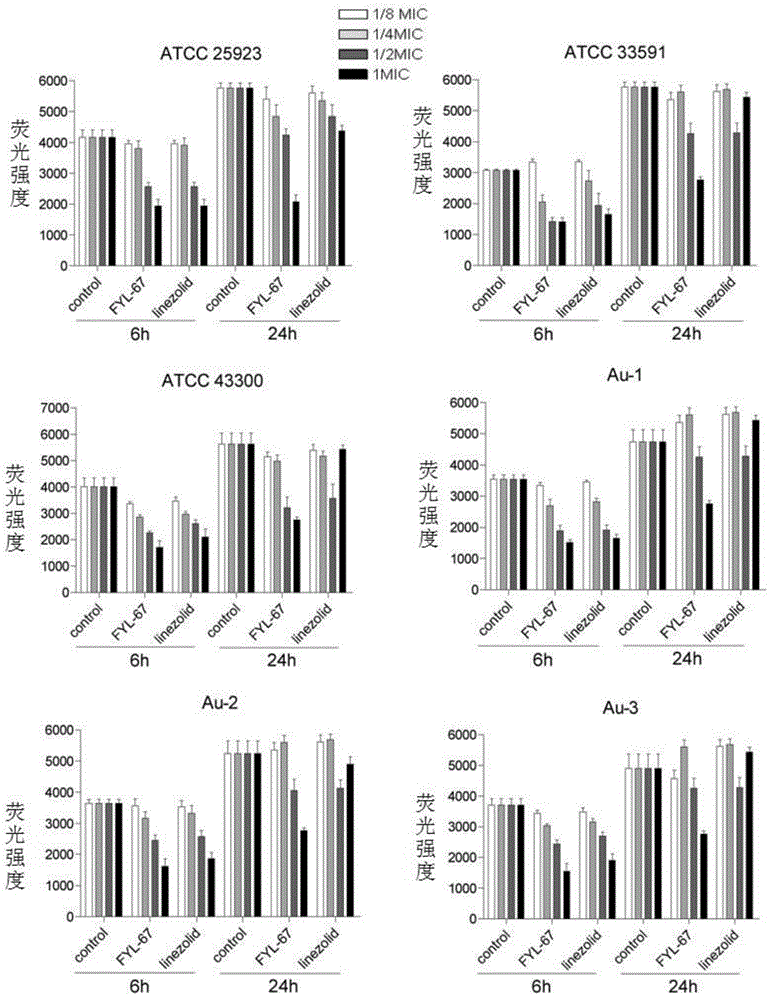Use of oxazolidinone compound for resisting biofilm
A technology of oxazolidinone and compound, which is applied in the field of oxazolidinone compound anti-biofilm, can solve problems such as ignorance, prevent or inhibit the formation of bacterial biofilm, reduce the quality of extracellular matrix, reduce biomass and The effect of viable count
- Summary
- Abstract
- Description
- Claims
- Application Information
AI Technical Summary
Problems solved by technology
Method used
Image
Examples
Embodiment 1
[0071] Example 1 Staphylococcus aureus MSSA, MRSA and clinical isolate biofilm phenotype
[0072] microplate method [1]、[2] The biofilm was cultured, and the number and activity of Staphylococcus aureus biofilm bacteria were detected by crystal violet and resazurin staining to detect the phenotypic mechanism of biofilm formation of MSSA, MRSA and clinical isolates.
[0073] MSSA strain ATCC25923 formed a mature biofilm at 24 hours, compared with the early biofilm formed at 6 hours, the biomass (Biomass) and the number of viable bacteria of the mature biofilm increased by 4.5 and 2.7 times, respectively. Compared with the early biofilm of MRSA strains ATCC33591 and ATCC43300, the mature biofilm had an increase of 7-8 times and 2-4 times in the biomass and number of viable bacteria of the biofilm. Mature biofilms formed by clinical isolates (Au-1, Au-2, and Au-3) showed similar trends, with 15-20 times more bacteria and 4.5-6 times more bacterial activity than 6h biofilms ( f...
Embodiment 2
[0075] The MIC of embodiment 2 medicine of the present invention, MBC and MBEC detect
[0076] The minimum inhibitory concentration (MIC) of FYL-67 or linezolid against planktonic Staphylococcus aureus was detected by the microdilution method recommended by NCCLS. The minimum bactericidal concentration (MBC) was determined by the double-dilution plate viable count method in broth, and the minimum biofilm eliminating concentration (MBEC) was determined by the colony count method after biofilm formation.
[0077] The in vitro activity results of FYL-67 against clinical isolates MSSA and MRSA are shown in Table 1.
[0078] Table 1
[0079]
[0080] From the results in Table 1, it can be known that the MIC value of FYL-67 to MRSA and MSSA ranges from 0.5-1ug / ml. The MBEC values of FYL-67 and linezolid for MSSA and MRSA were between 128-256 mg / l and 256-516 mg / l, respectively. The MIC value of the control strain Staphylococcus aureus ATCC25923 to the antibiotic linezolid re...
Embodiment 3
[0081] The impact of embodiment 3FYL-67 on biofilm formation
[0082] The microplate method was used to cultivate the biofilm, and the effects of FYL-67 and linezolid on the formation of early biofilm and mature biofilm were detected by staining with crystal violet and resazurin, and linezolid was used as the control ( figure 2 and 3 ).
[0083] The early biofilm formed by ATCC25923 was treated with 1 / 8, 1 / 4, 1 / 2, 1MIC concentration of FYL-67 or linezolid, compared with the control group without drug treatment, the biomass of the early biofilm was reduced About 50%.
[0084]When 1 / 8-1 / 4MIC of FYL-67 or linezolid treated MRSA strains, the biomass did not decrease. However, FYL-67 reduced MRSA biomass by 20-25% and 63-72% at 1 / 2MIC and 1MIC, respectively. 1 / 2MIC and 1MIC linezolid treated MRSA early biofilm, and the biomass decreased by 10-15% and 59-63%, respectively. The early biofilms formed by the three clinical isolates had basically the same changes in biomass after ...
PUM
| Property | Measurement | Unit |
|---|---|---|
| Thickness | aaaaa | aaaaa |
| Thickness | aaaaa | aaaaa |
| Thickness | aaaaa | aaaaa |
Abstract
Description
Claims
Application Information
 Login to View More
Login to View More - R&D
- Intellectual Property
- Life Sciences
- Materials
- Tech Scout
- Unparalleled Data Quality
- Higher Quality Content
- 60% Fewer Hallucinations
Browse by: Latest US Patents, China's latest patents, Technical Efficacy Thesaurus, Application Domain, Technology Topic, Popular Technical Reports.
© 2025 PatSnap. All rights reserved.Legal|Privacy policy|Modern Slavery Act Transparency Statement|Sitemap|About US| Contact US: help@patsnap.com



